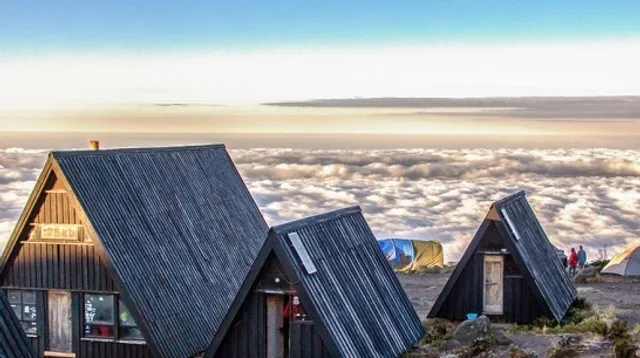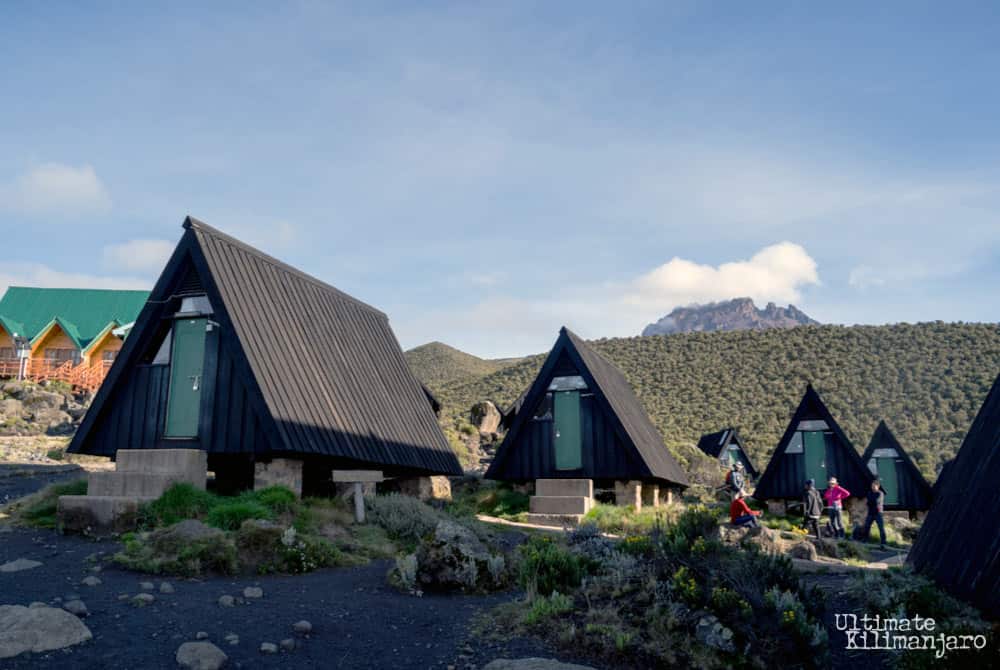The Marangu (Coca-Cola) route is the most popular route up Kilimanjaro, hence the name. It is a busy route through the rainforest of Marangu village, into the heather and moorland, then into the alpine saddle desert between Mawenzi and Kibo, and up to the crater rim at Gillman’s Point, which only half of all trekkers reach. It is a relatively smooth trail, winding through beautiful scenery, which changes considerably each day.
5 Days Kilimanjaro Marangu Route Overview
The 5-day route is physically challenging for most people, as the acclimatization time is short and the overnight hike to the top requires mental and physical strength. The trail from the highest hut to the summit deviates into steeper and rockier terrain and is difficult for most people.
Accommodation is in A-style huts on this route, except Kibo Hut, which is a stone building with separate rooms to accommodate climbers. All sleeping huts have foam mattresses and pillows on wooden bunk beds, and all eating huts have benches and tables for meals. All huts except Kibo have running water and all have toilets.
Itinerary
Depart Arusha at 8:00 am about 2 hours to Marangu village. Once you arrive at the gate, and after completing the paperwork and meeting the porters and guides, begin the 4-5 hour walk to Mandara Hut. The walk is at a leisurely pace through dense, wet forest to the hut. If you feel up to it at the end of the day, walk to the nearby Maundi Crater for a long view of the plains and Lake Jipe, and in the distance; the Paré and Usambara Mountains. The night is spent inside one of the huts.
After about 45 minutes in the forest, you will suddenly come upon an area of tall grass in the heath belt, which as the hike continues becomes more and more deserted, into the moor. Approximately 5-6 hours of walking brings you to Horombo Hut and a stunning view of Mawenzi Peak. The night will be spent in one of the huts.
The day’s trek will take approximately 6-7 hours. You will cross the arid and exposed alpine desert of the saddle between Kibo and Mawenzi. The last fresh water point is at 14,100 ft (4,300 m), where it will be necessary to fill your water bottles. Porters will carry the rest of the water needed for food and hot drinks. The saddle crossing is impressive and the scenery is spectacular. Overnight stay at Kibo Hut.
The next dat, you'll be woken up early with coffee or tea and depart between 12:30 and 1 am. You'll hike through the night on a winding scree path of endless switchbacks, ranging from just below freezing to -10 F. at Gillman’s Point. Once you reach the crater rim, gather your strength for another 1.5-hour hike to Uhuru Peak, the highest point at 19,340 feet. After a short time at the summit, descend the steep scree path to Kibo Hut for a rest, and further to Horombo Hut for the night. It's going to be an unforgettable journey. Best of luck!
Walk straight down to the Marangu Gate, which will take about 6 hours to complete. On arrival at the gate, you will have lunch and then be transferred to Arusha as per your schedule Marking the end of your 5 Days Kilimanjaro Marangu Route.
Cost Includes
- Safety Equipment:
- Mobile phones – carried by the head guide and all assistant guides, for daily communications
- with our base in Arusha. For any emergency
- Stretcher (and convertible litter)
- Comprehensive medical/first aid kits
- MOUNTAIN CREW:
- Professional Mountain Guides, all head guides (at least 1 per trip) currently certified by NOLS
- USA as WFR (Wilderness First Responder)
- The ratio of at least one guide for every three guests, to ensure personalized attention.
- Cooks and Porters
- MOUNTAIN ENTRY FEES:
- Park Fees
- Campsite fees
- Emergency Rescue Fees
- CAMPING EQUIPMENT AND OTHER GEARS:
- 4-season Mountain sleeping tents (a triple tent used as a double or single (with supplement),
- each tent with a custom-made groundsheet covering both vestibules, to allow clean & dry
- storage of gear, and keeping water, mud, or dust from entering the tent.
- Foam Camping Mat
- Large weatherproof dining tent, at night the tent is lit with candlelight, This tent is used for
- breakfast, lunch, and dinner if the weather does not allow it.
- Aluminum dining tables and chairs, for all meals.
- MOUNTAIN MEALS
- *Three meals a day, we produce and prepare delicious and energizing meals necessary for high
- altitude mountain trekking.
- Snakes & bites
- Tea and coffee
- Mineral water
- TRANSPORT
- Transfer from the hotel to the starting point
- Transfer from the last point to the hotel
Cost Excludes
- Accommodation upon arrival and last day
- Tips for a mountain guide, recommended 15-20 per group per day
- Porters 5 – 10$ per porter per group per day
- Personal expenses
- Personal items
- Personal insurance/travel insurance
- Personal medicines/first aid kit
- Personal trekking gears
- Sleeping bag
When preparing for a Kilimanjaro climb, it’s important to have the appropriate gear. Your gear list should include layered clothing (including an insulated jacket and warm gloves), high-quality hiking boots, a 4-season sleeping bag, a headlamp, and a water bottle. However, these are just the basics. To better understand what gear you’ll need and why, please use the links below to navigate to each section of our Kilimanjaro kit checklist.
If you’re planning to hike Mount Kilimanjaro, it’s important to understand the different climatic zones you’ll encounter, which can range from warm and tropical at the base of the mountain to freezing on the summit. To ensure your comfort during the hike, it’s crucial to layer your clothing appropriately, allowing you to add or remove layers as the weather changes. Each layer should be made of wickable fabric that hugs your skin, with cotton being avoided as it doesn’t allow moisture to pass through.
Here are the layers of Kilimanjaro clothing you’ll need to bring with you:
1. Underwear: Bring 4-5 pairs of sports underwear for a trek lasting less than 8 days, and two pairs of sports bras for women. Brands like Jokey and Icebreaker are recommended.
2. Base Layers (Top and Bottom): You’ll need a lightweight base layer over your underwear as you approach the upper reaches of the mountain. Smartwool or Icebreaker Base Layers made from 100% Merino wool are recommended, and Patagonia Capilene base layers are great synthetic alternatives for those allergic to wool. For treks lasting less than 8 days, one pair of top and bottom base layers should be sufficient, while for treks lasting over 8 days, you’ll need at least 2 pairs.
3. Hiking Shirts: Bring 4 short-sleeved shirts and 2 long-sleeved shirts made of breathable, lightweight, and quick-drying polyester, merino, or nylon. Avoid cotton. Brands like Icebreaker, Craghoppers, Columbia, and Patagonia are recommended.
4. Hiking Trousers/Pants: Bring 1-2 pairs of hiking trousers, with an additional pair ideal for treks lasting more than 7 days. Bring 1 pair of trekking shorts if preferred. Brands like Columbia, Kuhl, Fjallraven, or Craghoppers are recommended.
5. Fleece Insulation Layer: Bring one mid-weight fleece jacket or parka top for colder stretches on the hike and summit night. Polartec fleeces in 200s provide great warmth and comfort. Brands like North Face, Helly Hansen, and Patagonia are recommended.
6. Core Insulated Jacket or Third Layer: This is a critical piece of kit for Kilimanjaro, keeping your core extra warm on summit night. Choose an insulated jacket based on its weight and warmth, with down providing the greatest weight-to-warmth ratio. Brands like Columbia, Marmot, The North Face or Arc’teryx are recommended.
Kilimanjaro boots and footwear are crucial for a successful mountain climb. In this article, we’ll provide guidelines on the key features to look for in a pair of boots and recommend some affordable options.
Remember that your feet are what will help you reach the top and come back down safely, so it’s important to follow the tips in this article to avoid sore feet, blisters, and lost toenails. Check out our guide to hiking Mt Kilimanjaro and download our Kilimanjaro equipment list for more information.
When looking for trekking boots, there are three main features to consider: fit, quality, and use. A wrong decision on any of these could result in foot injuries, back pain, lost toenails, and blisters.
Fit is the first characteristic to look for. To test the fit of a boot, put your foot in the boot and slide it forward until your toes reach the front of the boot (make sure you’re wearing an average cushioned sports sock). Then, take your index finger and slide it down the back of the boot between your heel and the boot support.
A well-fitting boot should allow you to insert your finger without too much resistance. If you can’t insert your index finger, the boot is too small, while if your finger fits too easily, the boot is too big. A snug fit, with your index finger in the back of the boot, is the right fit.
Quality doesn’t have to be expensive, and you can find affordable trekking boots that are of great quality. The following features define good quality boots:
– Medium to high tops for sturdy ankle support. The higher the top, the heavier the boot.
– The sole of the boot should have a high rubber content and deep lugs for better traction. The deeper the lugs, the heavier the boot.
– Medium to heavy weight. Heavy boots are durable and cushioned, but they can be tiring to hike in. We recommend medium-weight boots.
– Waterproof. This is standard today, and Gore-Tex material is recommended for improved waterproofing. Combined with waterproof socks, you can keep your feet dry.
– The lacing system should incorporate D-Strings and speed hooks for better ankle support and fast lacing.
Once you have a good-fitting pair of boots with similar characteristics, it’s essential to break them in. Never arrive at Kilimanjaro with brand-new boots that you’ve never worn. Wear your boots as often as possible before your hiking date and undertake 2-3 long-distance treks (4-5 hours a day) to break them in.
Tanzania has three major international airports:
- Dar es Salaam (DAR)
- Zanzibar (ZNZ)
- Kilimanjaro Airport (JRO)
The latter is the most convenient for Kilimanjaro, sitting only 42 km away from the mountain town of Moshi and 50 km from Arusha. In addition to flights to Tanzania, you may consider flights to Nairobi in Kenya, which is only a 5-hour shuttle bus ride to Arusha or a 1-hour plane ride to JRO. Note, however, that by choosing to fly to Kenya you may need a multiple-entry Kenya visa (if you are flying out of Kenya, too, for example, and spend longer than a fortnight in Tanzania), which can cost as much as $122 – thereby reducing or eliminating any saving you may have made in airfares.
In deciding which flights to book, you should take the full trip into consideration. For example, if you would like to spend a couple of days in Zanzibar after the climb, it might be best to book one-way tickets from your home to Kilimanjaro Airport for the climb, from Arusha to Zanzibar after the climb, and then from Zanzibar back to your home.













